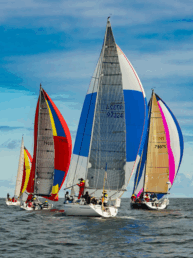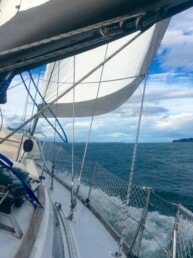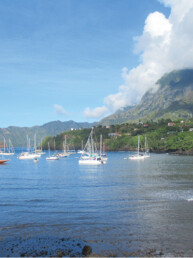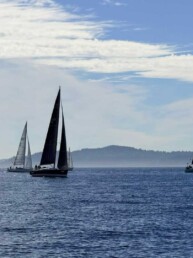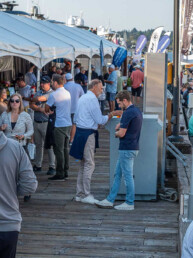Boat Life’s Inherent Eco-Friendly Attributes
From the April 2020 issue.
Anchored at Cortes Island after a glorious month cruising points north, we awaited the arrival of two Seattle-based friends who were joining our family of four for a few days in Desolation Sound. We suggested that they bring some supplemental food and pack lightly, since there was limited storage on a 42-foot sailboat with six passengers.
My husband, Dan, dinghied ashore and ferried them aboard. To our surprise, two suitcases, a hamper full of food, and the human cargo quite overwhelmed our small dinghy. We hoisted everything on board and began the process of figuring out where to stow it all.
During the course of the next few days, having people on board who were not accustomed to living with limited water, battery power, and trash disposal facilities, brought into stark relief the ways boat life had caused us to change our habits, and it was most apparent when cruising.
With this influx of “normal” food and living supplies, our trash bag was full in only one day; as opposed to one-to-two weeks, as we were used to. Food packaging, paper towels, single serve items, and drink bottles overflowed the receptacle.
The door to our crammed fridge remained open for longer periods of time as we searched for an item we needed. Dan—always monitoring our energy usage—cringed as the cool air escaped, knowing that he’d have to charge the batteries before long if this kept up.
Despite instructions to our guests about the need to conserve water, our tanks were nearly drained within a few days—even with four people aboard, we normally expect to get multiple weeks from our 120-gallon supply. Not wanting to be a nag (after all, this was our guests’ vacation, too), I either bit my tongue or gently suggested different ways of doing things. We all got through it unscathed, but it definitely made me think about the ways boat living has affected the choices we make, and the effects our choices can have on the environment.
Thirty years of cruising and twelve of living aboard have, in effect, rewired my brain. I’ve learned and incorporated new habits, automatically making choices that suit our lifestyle but also that are in line with what experience has shown us is important. Living in close proximity to nature, I am keenly aware of our responsibility to protect the creatures with whom we share our marine environment. They depend on us to keep their habitat healthy.
Waste Reduction and Tips for Cruisers
A key habit I have carried over from cruising to liveaboard life is to keep close track of what is in the fridge and plan meals and grocery store runs to minimize waste and maximize space. When cruising, given a choice between metal, glass, or plastic, we always choose cans that we rinse in saltwater, flatten and stow until we are able to recycle them. Same with paper or cardboard packaging. We store smelly, wet food waste in a sealable container until we are able to dispose of it. Back at the marina, we compost our food waste. There are many situations when we utilize reusable containers when shopping too. That’s the best case scenario.
I’m not judging those who don’t have these same habits, because I get it. It’s easy to unconsciously put trash in the bin and move on. Same with recycling. Out of sight, out of mind, right?
Well, the massive garbage patches floating around the oceans—one that now measures 1.6 million square kilometers, twice the size of Texas—would beg to differ (Kevin Loria, “The giant garbage vortex in the Pacific Ocean is over twice the size of Texas – here’s what it looks like,” Business Insider 2018). The plastic is destroying ecosystems in both its macro and micro forms, and killing the creatures who depend upon healthy oceans. The sad truth is, some of what we think we are recycling is not actually being recycled. It’s being shipped overseas and ending up as trash or in landfills (Erin McCormick, “Where does your plastic go? Global investigation reveals America’s dirty Secret,” The Guardian, 2019) where it is not out of sight and is very much on the minds of people who live near those landfills or sail through those plastic islands. That’s not to say we shouldn’t recycle, but rather that those who take action for the good of the earth and the oceans must not only recycle, but reduce their plastic usage.
Forming New Habits
According to Phillippa Lally, a health psychology researcher at University College London, it takes two months to form a new habit. Most of us are now in the habit of bringing reusable bags to stores. But remember when it wasn’t automatic? If we forgot and left our bags in the car, we chose between “paper or plastic,” promising ourselves to remember next time. Eventually, it became our norm.
 After encountering a goose on our dock with a six-pack ring tightened around her neck a couple of years ago, I resolved to kick plastic to the curb. I began by avoiding plastic wrapping wherever I could. But I still reached for the same old yogurt I was used to buying. I still bought lip balm in plastic tubes. My favorite sunscreen and face moisturizer? Both in plastic. Yikes. Brushing my teeth one day I squeezed toothpaste out of the plastic tube onto my plastic toothbrush and, with my mouth full of foam, thought, wait a minute … this too?
After encountering a goose on our dock with a six-pack ring tightened around her neck a couple of years ago, I resolved to kick plastic to the curb. I began by avoiding plastic wrapping wherever I could. But I still reached for the same old yogurt I was used to buying. I still bought lip balm in plastic tubes. My favorite sunscreen and face moisturizer? Both in plastic. Yikes. Brushing my teeth one day I squeezed toothpaste out of the plastic tube onto my plastic toothbrush and, with my mouth full of foam, thought, wait a minute … this too?
Now, after a couple of years, my new habits are ingrained. I make yogurt—it’s easy and delicious. When I see that I’m getting low, I automatically make a new batch. I make lip balm and keep it in small, glass containers. It, too, is easy to make and contains much healthier ingredients than store-bought options. When I run out, I add “make more lip balm” to my to-do list instead of “buy more” to my shopping list. I bought a bamboo toothbrush and I either buy natural toothpaste in glass containers or make my own. It took a while, though. And it took patience and diligence to make these habits stick.
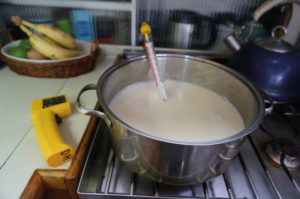 Can our small efforts really make a difference? Some argue no—it has to come from those in power or via society-wide changes. But recent articles have given me hope. In “How Peer Pressure Can Help Stop Climate Change” (Washington Post Feb. 20, 2020), author, Robert Frank, argues that despite critics’ belief that individuals’ actions will have little impact on global warming’s deep systemic causes, it is an essential step. Once social contagion, or peer pressure, enters the equation, things do tend to change. Solar panel installation is a well-documented example of behavioral contagion and “…the purchase of low-emissions vehicles carries special cachet,” suggests Frank.. In one New York University and Yale study, new solar installations in a zip code increased the probability of another within four months and extended beyond neighborhood boundaries. If there was ever a time when peer pressure was a good thing, this is it!
Can our small efforts really make a difference? Some argue no—it has to come from those in power or via society-wide changes. But recent articles have given me hope. In “How Peer Pressure Can Help Stop Climate Change” (Washington Post Feb. 20, 2020), author, Robert Frank, argues that despite critics’ belief that individuals’ actions will have little impact on global warming’s deep systemic causes, it is an essential step. Once social contagion, or peer pressure, enters the equation, things do tend to change. Solar panel installation is a well-documented example of behavioral contagion and “…the purchase of low-emissions vehicles carries special cachet,” suggests Frank.. In one New York University and Yale study, new solar installations in a zip code increased the probability of another within four months and extended beyond neighborhood boundaries. If there was ever a time when peer pressure was a good thing, this is it!
Boaters Are Environmentalists
As boaters, we experience nature deeply, intimately. We know first-hand the beauty of the inlets and oceans, the magic of watching dolphins frolic in a bow wake, whales surface in the distance and seals play around our boats. We stop in our tracks to watch kingfishers darting about, chattering as they hunt, eagles and osprey circling overhead, and sea fowl migrating with the change of seasons. Even those beggarly Canada Geese (including the one I was able to untangle from its plastic noose), who glide up and down the fairways around dinnertime, hoping for an upscale dining experience, are part of our neighborhood and dependent on our decisions.
It is a no-brainer that those of us who experience these wonders would want to preserve them, and boat life already gives us many of the parameters to be better stewards. We can and should be leaders on a small and large scale in the fight for our fragile earth and oceans.
Irene Panke Hopkins
Irene Panke Hopkins is an essayist who cruised and lived aboard her Discovery 42 sailboat for many years. She's now enjoying a new experience with land life in Port Townsend, Wash.

